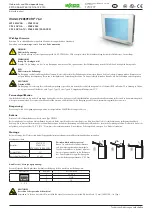
EL640.480-A SB Series Operations Manual (020-0358-00A)
9
Self Test
The operation of the display can be tested using the SELFTST control input
(J1/26). Self test is performed if SELFTST is HIGH or left disconnected. By
applying power to the display without any other input, the display starts
scanning, displaying all pixels with full brightness except a pattern of unlit
pixels in the center of the topmost row.
Display Enable
The operation of the display can be shut off for screen save or minimal power
consumption by a LOW state on ENABLE control input (J1/28). When disabled
power consumption of the display drops to appr. 2 W. In normal operation
ENABLE input should be pulled HIGH or left disconnected (internal pull-up)
Brightness Control
The brightness of the display can be adjusted from below 20% up to full
brightness by a 50k
Ω
external logarithmic potentiometer between LUMPOT1
and LUMPOT2 control inputs (J3/1 and /2 respectively). The control function is
achieved by sinking a small (<0.5 mA typ.) current from LUMPOT1 to LUMPOT2
(When open, the voltages are at 5 V and 0 V respectively).
If the two inputs are left disconnected, the brightness is at its maximum level.
Low Power Mode
The Low Power function reduces power consumption of the display to
typically 11 W. The function reduces slightly the contrast and average
brightness of the display. The function is selected by LOW state in _LOWPOW
control input (J1/30). If the input is pulled HIGH or left disconnected, normal
operation is selected.
Two Data Parallel Mode
For compatibility with flat panel controllers, it is possible to input the data of
two pixels simultaneously by using the secondary data input lines D4–D7. This
mode is selected when solderable bridge DCON is open. In default
configuration bridge DCON is set.
Notice: Only binary coding of input data can be used with Two Data Parallel
mode. See Gray Shades.
EMC
The conductive metal assembly support between the display glass and the
electronics as well as the metal back cover act as a ground plane for EMI
signals. In conjunction with data input connector J1, there is a connection lug
from assembly support through the ECA. This lug can be used to ground the
shield of the signal input cable. Note that the assembly support is also
connected to the signal ground of the display (GND in J1).
For best EMC performance, the four display mounting ears should be tied to
customer chassis ground. Care should be taken to avoid loops in system
grounding.












































